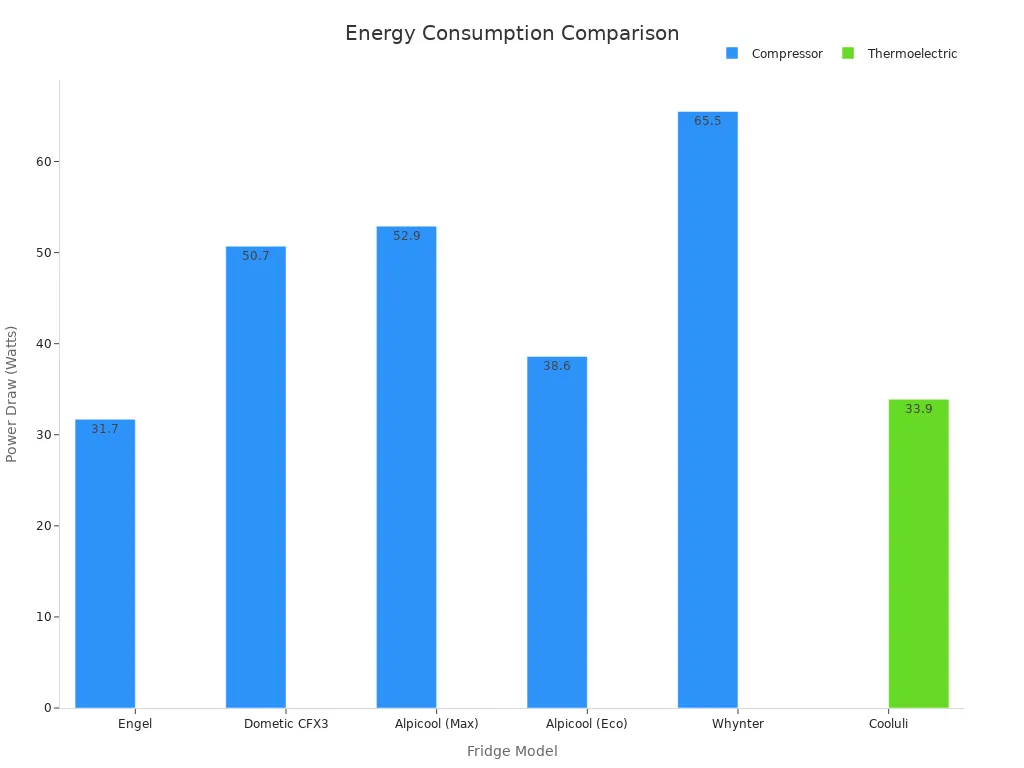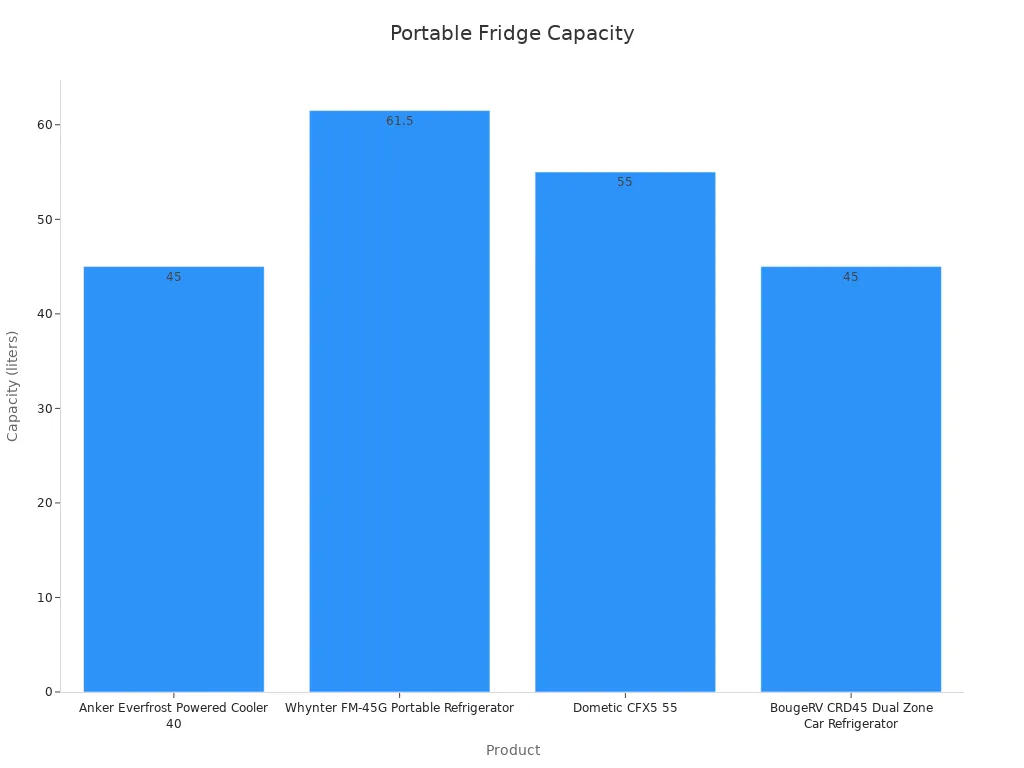
Long journeys call for dependable cooling solutions, and a portable car fridge delivers unparalleled convenience. With compressor-driven technology, these portable fridge for car options provide exceptional cooling performance, keeping your food and beverages fresh for extended durations. Designed to consume minimal power, they are a favorite among eco-conscious travelers. As adventure tourism and road trips gain popularity, a mini portable refrigerator has become a must-have travel companion. Consumers are increasingly drawn to energy-efficient models, thanks to technological advancements that enhance both reliability and environmental sustainability. Whether you’re camping or embarking on a cross-country adventure, a portable freezer for car use ensures both comfort and practicality throughout your journey.
Understanding Compressor-Driven Portable Car Fridges

How Compressor Technology Works
Compressor technology forms the backbone of modern portable car fridges, delivering superior cooling performance. At its core, this system uses a refrigerant that cycles through compression and expansion processes. The compressor pressurizes the refrigerant, causing it to heat up. As it moves through the condenser coils, the heat dissipates, and the refrigerant cools down. This cooled refrigerant then absorbs heat from the fridge’s interior, effectively lowering the temperature.
Innovations in compressor-based systems have significantly improved their efficiency and reliability. Enhanced insulating materials and advanced engineering ensure consistent cooling, even in extreme temperatures. These advancements align with the growing demand for efficient refrigeration solutions, particularly among travelers seeking dependable cooling during long journeys.
Benefits Over Thermoelectric Fridges
Compressor-driven fridges outperform thermoelectric models in several key areas. First, they offer a wider temperature range, often capable of freezing items down to -4°F (-20°C). Thermoelectric fridges, by contrast, struggle to maintain consistent cooling in hot environments. Second, compressor models consume less power relative to their cooling capacity, making them more energy-efficient.
The following table highlights the energy consumption differences between popular compressor and thermoelectric models:
| Model | Power Draw (Watts) | Type |
|---|---|---|
| Engel | 31.7 | Compressor |
| Dometic CFX3 | 50.7 | Compressor |
| Alpicool (Max) | 52.9 | Compressor |
| Alpicool (Eco) | 38.6 | Compressor |
| Whynter | 65.5 | Compressor |
| Cooluli | 33.9 | Thermoelectric |

Compressor fridges also operate more quietly, thanks to advancements in motor design. This makes them ideal for use in confined spaces like cars or RVs, where noise levels can impact comfort.
Why They’re Ideal for Long Journeys
Compressor-driven portable car fridges excel in long-distance travel scenarios. Their ability to maintain consistent cooling, even in fluctuating ambient temperatures, ensures food and beverages stay fresh throughout the journey. For instance, the VEVOR Car Refrigerator can cool from 20°C to 0°C in just 15 minutes, demonstrating its rapid cooling capabilities.
These fridges also feature advanced battery protection systems, which prevent vehicle battery depletion. The VEVOR model includes three protection levels, ensuring safe operation during extended trips. Additionally, compressor fridges are designed for stability, functioning efficiently even when tilted at angles up to 45°. This makes them suitable for bumpy roads and off-road adventures.
User feedback highlights their reliability, with some models maintaining food freshness for up to 10 hours after a power cut. This feature allows travelers to enjoy meals without worrying about spoilage, making compressor-driven fridges an indispensable tool for outdoor enthusiasts.
Features to Look for in a Portable Car Fridge
Cooling Performance and Temperature Control
A portable car fridge must excel in cooling performance to ensure food and beverages remain fresh. Advanced models often feature dual-zone capabilities, allowing users to set different temperatures for separate compartments. This flexibility is ideal for storing both frozen and chilled items simultaneously.
Key performance metrics include rapid cooling capabilities and temperature uniformity. High-quality insulation, such as thick walls and airtight seals, enhances cooling efficiency by minimizing heat exchange. Many models, like the BougeRV CRD45, can reach temperatures as low as -4°F, making them suitable for freezing needs. Additionally, refrigerators equipped with multiple temperature sensors ensure precise thermostat control, maintaining consistent cooling even in warm environments.
- Key Features to Consider:
- Rapid cooling for quick temperature adjustments.
- A wide temperature range, especially for freezing.
- Reliable insulation for energy-efficient operation.
Energy Efficiency and Power Consumption
Energy efficiency is a critical factor for long journeys. Compressor-driven fridges consume less power while delivering superior cooling. Models like the Dometic CFX5 55 and Anker Everfrost Powered Cooler 40 are designed to optimize energy use, ensuring minimal strain on vehicle batteries.
Battery protection systems are another essential feature. These systems prevent over-discharge, safeguarding the car’s battery during extended trips. For eco-conscious travelers, selecting a fridge with low power draw and high cooling efficiency ensures both sustainability and cost savings.
Portability and Compact Design
Portability is vital for a fridge designed for travel. Compact units, such as the Anker Everfrost Powered Cooler 40, combine lightweight construction with features like roller wheels and removable baskets for easy transport. These fridges are ideal for RVs, cars, and even tiny homes, where space is limited.

Design studies highlight the importance of space efficiency. Portable car fridges come in various shapes and sizes, ensuring compatibility with different vehicle interiors. Their compact design allows for seamless integration into tight spaces without compromising storage capacity.
Durability and Build Quality
Durability is non-negotiable for outdoor and travel use. Portable car fridges must withstand harsh conditions, including extreme temperatures, rain, and rough handling. Models like the BougeRV CRD45 are built with rugged materials, ensuring long-lasting performance.
Durability tests often evaluate resistance to weather elements and physical stress. High-quality construction materials, reinforced corners, and sturdy handles contribute to a fridge’s ability to endure demanding environments. Travelers should prioritize models with proven durability to ensure reliability during their adventures.
Best Compressor-Driven Portable Car Fridges: A Comparison

Overview of Top Models
When selecting a portable car fridge, travelers often prioritize performance, durability, and energy efficiency. Several models stand out in the market due to their advanced features and reliable cooling capabilities. Below are some of the top-rated compressor-driven portable car fridges:
- Dometic CFX3 55IM
- Known for its innovative design, this model includes a rapid-freeze plate and an ice maker. It offers excellent cooling performance and energy efficiency, making it a favorite among adventurers.
- BougeRV CRD45
- This compact yet powerful fridge is designed for long journeys. It features dual-zone cooling and a robust build, ensuring reliability in various environments.
- VEVOR Car Refrigerator
- With its fast cooling capabilities and advanced battery protection, this model is ideal for extended road trips. Its ability to function efficiently on uneven surfaces makes it a versatile choice.
- Anker EverFrost Powered Cooler 40
- Lightweight and portable, this fridge combines convenience with performance. It includes a built-in battery pack, ensuring uninterrupted cooling during outdoor adventures.
Key Specifications and Features
Understanding the specifications of portable car fridges helps travelers make informed decisions. The table below compares two leading models based on their technical details:
| Specification | Dometic CFX3 55IM | BougeRV CRD45 |
|---|---|---|
| Power Input | 52W | 60W |
| Insulation | PU Foam | PU Foam |
| Material Construction | PP+HIPS+HDPE+ABS+SUS304+SGCC | PP+HIPS+HDPE+ABS+SUS304+SGCC |
| Lithium Ion Powerpack | 31.2Ah | 31.2Ah |
| Climatic Category | T,ST,N.SN | T,ST,N.SN |
| Avg Amp per hour | 0.823A | 0.996A |
| Rated Voltage | DC 12/24V | DC 12/24V |
| Refrigerant | R134a/26g | R134a/38g |
| Dimensions (Exterior) | L712mm x W444mm x H451mm | L816mm x W484mm x H453mm |
| Weight (Empty) | 22.6kg | 25.6kg |
Both models feature high-quality insulation and durable construction, ensuring consistent cooling performance. Their energy-efficient designs minimize power consumption, making them suitable for long journeys.
Pros and Cons of Popular Choices
Every portable car fridge has its strengths and limitations. The table below summarizes the pros and cons of compressor-driven models based on user reviews:
| Pros | Cons |
|---|---|
| Most energy efficient on electricity | Usually more expensive |
| Temperature setting independent of outside air | N/A |
| Does not need to be perfectly level to work | N/A |
| Functions as both refrigerator and freezer | N/A |
Compressor-driven fridges excel in energy efficiency and cooling performance. Their ability to maintain precise temperatures, regardless of external conditions, makes them a reliable choice for travelers. Although they tend to be more expensive than thermoelectric models, their long-term benefits outweigh the initial cost.
Tip: When choosing a portable car fridge, consider your specific travel needs, such as storage capacity, power consumption, and portability. Investing in a high-quality model ensures a hassle-free experience during your adventures.
Tips for Maintaining and Optimizing Your Portable Car Fridge
Cleaning and Maintenance Best Practices
Proper maintenance ensures the longevity and reliability of a portable car fridge. Regular cleaning prevents the buildup of dirt and debris, which can affect cooling efficiency. A routine cleaning schedule should include wiping down the interior with a mild detergent and ensuring the condenser coils remain free of dust.
The table below outlines essential maintenance tasks and strategies to minimize wear and tear:
| Maintenance Task | Minimization Strategy |
|---|---|
| Regular Cleaning | Clean the interior and exterior surfaces periodically to prevent residue buildup. |
| Inspect for Physical Damage | Check for cracks or dents that could compromise insulation. |
| Seals and Gaskets | Inspect seals regularly and replace them if they show signs of wear. |
| Cleaning the Condenser and Coils | Remove dust and debris from the condenser and coils to maintain cooling efficiency. |
| System Wiring | Conduct routine checks of electrical connections to ensure proper functionality. |
Adhering to these practices not only enhances performance but also reduces the likelihood of costly repairs.
Efficient Packing for Better Cooling
Packing items efficiently inside the fridge improves cooling performance and energy use. Using insulated containers or gel packs helps maintain consistent temperatures. Additionally, separating food and beverages into different compartments minimizes warm air exposure when opening the fridge.
Here are some practical packing tips:
- Use two coolers: one for drinks and another for food.
- Fill the fridge to at least two-thirds capacity with ice or frozen items.
- Opt for larger ice blocks, as they melt more slowly and maintain lower temperatures longer.
These strategies, combined with high-quality insulation, ensure optimal cooling during long trips.
Managing Power Usage During Long Trips
Efficient power management is crucial for extended journeys. Many portable car fridges feature battery protection systems that prevent over-discharge. Travelers should monitor power consumption and use energy-saving modes when available.
To conserve energy:
- Pre-cool the fridge before loading it into the vehicle.
- Avoid frequent opening of the fridge to reduce temperature fluctuations.
- Use solar panels or external power sources to supplement energy needs.
By implementing these measures, users can maximize the fridge’s efficiency while preserving the vehicle’s battery life.
Compressor-driven portable car fridges offer unmatched cooling efficiency, energy savings, and durability. Travelers should evaluate factors like cooling performance, portability, and power consumption when choosing the ideal model. Investing in energy-efficient designs ensures a stress-free journey, allowing adventurers to focus on creating memorable experiences without worrying about food preservation.
FAQ
What makes compressor-driven portable car fridges more energy-efficient than thermoelectric models?
Compressor-driven fridges use advanced refrigerant technology, which consumes less power while delivering superior cooling. Their insulation and precise temperature control further enhance energy efficiency.
Can a compressor-driven fridge operate on uneven surfaces during travel?
Yes, most compressor-driven fridges function efficiently even when tilted up to 45°. This feature makes them ideal for off-road adventures and bumpy terrains.
How can users extend the lifespan of their portable car fridge?
Regular cleaning, inspecting seals, and avoiding overloading help maintain performance. Following the manufacturer’s maintenance guidelines ensures durability and long-term reliability.
Tip: Always pre-cool the fridge before loading items to reduce energy consumption during trips.
Post time: Apr-30-2025

